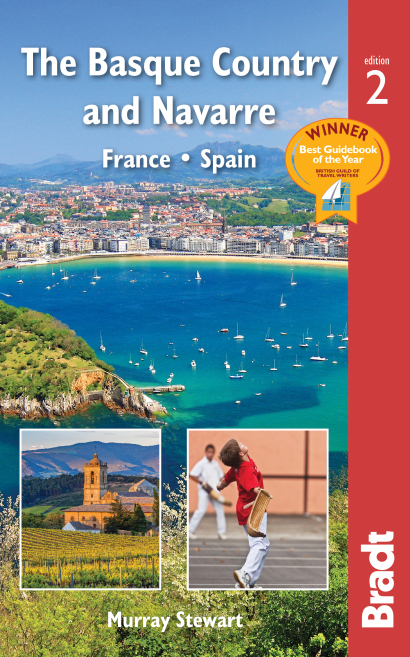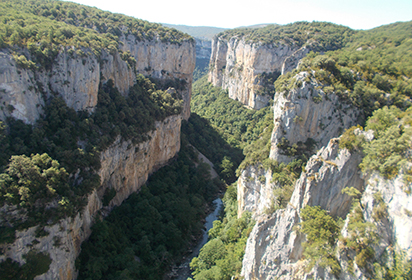My exhortation is simple: do what the locals do, and you are bound to be smitten by the Basque Country and Navarre.
Murray Stewart, author of The Basque Country and Navarre: the Bradt Guide
The Basque Country, spanning the French–Spanish border, is home to one of Europe’s oldest and strongest cultures. And Navarre, once a proud kingdom, clothes itself in fascinating landscapes that roll down from the Pyrenees to the banks of the Ebro River, through agricultural flatlands and the jaw-dropping scenery of semi-desert badlands.
Visitors flock to the striking cities that punctuate the regions north and south of the border. Bilbao, a rejuvenated giant reflecting in the glow of its sparkling Guggenheim museum; San Sebastián, stretching itself out along its famous beaches; Vitoria-Gasteiz, a city cloaked in green spaces; Pamplona, host to one of Spain’s most raucous festivals, all running with bulls and instant revelry.
North of the border, beautiful Biarritz glitters with elegance, a surfer’s paradise, while understated Bayonne has a trove of treasures to reveal to the curious.
But there’s more, far more, than urban delights. Coursing through the region are the well-trodden paths of the Caminos de Santiago. Travel in the 1,000-year old footsteps of pilgrims, discovering the region’s interior – rich in culture, awash with festivals.
Unlock some – but not all – of the mysteries of the Basque people: their language with its origins unknown; their cuisine, surely one of the world’s finest, bestowed with accolades but accessible to every budget.
Find yourself in a unique corner of Europe where the foreign and the familiar rub together, ensuring a trip that’s revealing and comfortable, exciting yet relaxing. And everywhere you travel, find yourself amongst people who are proud of what they have, but ever eager to share it.
For more information, check out our guide to the Basque Country and Navarre:
Food and drink in the Basque Country and Navarre
There is a saying that, for a Basque, the first priority is food and the second priority is ‘What’s for dinner?’ When one Basque suggests to another ‘Let’s go walking on the mountain on Sunday,’ the likely reply is not ‘Which mountain?’ but ‘What food shall we take?’ or ‘Which restaurant are we eating at afterwards?’ When reading a regional newspaper, it is not unusual to see a solemn announcement like this: ‘The Guild of the Beasain Black Pudding will hold its Annual Assembly tomorrow’. Food here is religion.
Quality is everything: every Basque has an opinion on where to find the best cheese, ham, seafood and chuletón (beef chop). Moreover, they will be very happy to discuss it at great length with each other and anyone prepared to listen. Good cuisine is universal: the people eat like kings and the kings (if there were any left) would eat like the people. This obsession with food does not mean that they gorge themselves irrespective of the consequences. You won’t see many overweight Basques, something which is partially due to a diet that is healthy – in both senses of the word – and partially due to their active lifestyle and love of sport.
What strikes the visitor is not just what the Basques eat, but also how, when and where they eat. The ‘what’ is usually straightforward, as cuisine is based on fresh seasonal ingredients, largely unadulterated, taken from the sea or brought down from the mountains. Simplicity is key. There is no need to spoil a decent piece of hake or sea bream with an elaborate sauce: in fact, some view such adornments with suspicion. Some fresh hake? Simply cook it with some oil and garlic and it will be deemed quite sufficient. A nice beef chop? Grill it and serve it on a plate, often without any vegetables to distract from the flavour.
Of course, although the freshness of ingredients is the most important factor, another strand to the region’s cuisine has developed in recent years. The rise of nueva cocina vasca (new Basque cuisine) demonstrates a highly creative and innovative approach that combines Basque traditions and recipes with the elevation of cooking to the status of kitchen art. Most evident in the higher-end restaurants, this cuisine comes at a price, but its quality and the value that it still represents is underlined by the accolades frequently heaped upon the region’s top chefs. This is a region that glitters with Michelin stars.
Health and safety in the Basque Country and Navarre
Health
There are no serious health issues to worry about, and no endemic diseases. Insect bites are perhaps the biggest risk in rural areas so it is worth taking an insect repellent. It is wise to be up to date with the standard UK vaccinations including diphtheria, tetanus and polio which comes as an all-in-one vaccination (Revaxis), and which lasts for ten years.
If you do have an accident or fall ill, the level of healthcare is on a par with much of the rest of Europe. Residents of EU countries including the UK and Ireland should obtain a European Health Insurance Card (EHIC) before travelling, as this covers the costs of any standard medical treatment you may require.
This is available in the UK by calling 0845 606 2030, or online. Everyone, including holders of an EHIC, should also take out travel insurance that includes medical costs, as the EHIC doesn’t cover all eventualities, such as repatriation to your home country following an accident.
In a medical emergency in either Spain or France, you should dial 112 to call for an ambulance.
Safety
Of course, anything can happen, anywhere in the world, but the good news is that both Spain and France enjoy lower crime rates than, for example, the UK or the USA. All the Spanish Basque provinces have much lower crime rates than either Madrid or Barcelona, which according to official statistics are Spain’s crime ‘danger areas’. Here you won’t be plagued by bag-snatchers or pickpockets as you might be in the more famous tourist hot spots. Navarre’s crime rate is also lower than the Spanish average.
In France, the département of Pyrénées-Atlantiques (which includes the three former Basque provinces) has a crime rate which is lower than the French average. In general, there are no specific safety concerns for visitors to the Basque Country or Navarre and, if common sense is applied, it is perfectly reasonable to expect a trouble-free visit.
For anyone worried about the activities of ETA, the armed organisation that once used violent tactics to fight for Basque independence, they officially declared a ‘definitive cessation to its armed activities’ in October 2011, and no violent incidents have occurred since then. If you are puzzled by the black and white banners hanging from balconies, particularly in Gipuzkoa and Bizkaia, imploring ‘Euskal presoak Euskal Herrira’ and accompanied by a map of the ‘seven Basque provinces’ then this translates as ‘[Bring] the Basque Prisoners back to Euskal Herria’ and refers to the many convicted Basque prisoners pointedly being made to serve their sentences in places as far away as Seville or Tenerife.
Of course, both France and Spain have been subject to terrorist attacks from so-called Islamist groups in recent years, but to date these have not directly affected the Basque Country or Navarre.
Travel and visas in the basque Country and Navarre
Visas
Citizens of the UK, Ireland and other EU countries do not at present need a visa to visit either France or Spain. A valid passport or national identity card is sufficient. There is no 90-day limit on the length of stay, though there are certain limitations imposed on citizens of some of the countries that have recently joined the EU. Citizens of the USA, Canada, Australia and New Zealand and certain other countries can visit France or Spain as tourists for up to 90 days with a valid passport, and have no need of a visa.
Citizens of other countries visiting France or Spain will need to obtain a Schengen visa, valid for up to 90 days, which involves showing that you have sufficient funds and the necessary travel insurance. You should apply well in advance. Note that possession of a Schengen visa allows the holder to travel throughout the 26 Schengen countries during the period for which the visa is valid. Schengen visas cannot be extended.
Getting there and away
By air
Whether accessing the region through France or Spain, the ever-increasing tentacles of budget air travel allow the visitor direct flights, principally through Biarritz or Bilbao, from London and a few regional UK airports. Not all flights are operated daily. Given that new flights regularly appear or are removed, it’s a good idea to check the airport websites (as well as the airline websites listed below) or a site such as Skyscanner in case an airport near you has suddenly acquired a connection to the region. Note that the flight schedules of budget airlines can be reduced (or suspended) in winter.
For those arriving on long-haul flights from the USA, Canada or elsewhere, it will almost certainly be necessary to fly first to either Madrid or Barcelona (or even London) and connect to Bilbao, San Sebastián, Vitoria-Gasteiz or Pamplona (for the Spanish provinces), or fly to Paris and connect to Biarritz for the French Basque Country.
By boat
For those wishing to take their own vehicles to the Basque Country, there are direct ferries from the UK to Bilbao. Sailing to Santander, in the neighbouring province of Cantabria, is another option with a drive of only around an hour to reach western Bizkaia province. Schedules vary according to season, as do prices, and while they are not cheap, could make sense for a party or family of four, taking into account that you won’t have to pay for car hire when you arrive.
Getting around
For maximum flexibility, use of a car is advisable, and almost essential if you are visiting the remoter outposts of this region. If you are based in one place, however, and taking into consideration fuel prices, motorway tolls, parking costs and scarcity of spaces, making use of public transport for some trips while you are in the region is worth considering and often the extra cost is negligible, especially if you are travelling as a couple or on your own.
By car
Unless you are bringing your own vehicle, a self-drive hire car is recommended. All you need is a UK, other national or international driving licence, a passport and a credit card. Vehicles can be picked up and returned at airports or in city centres.
By train
RENFE in Spain and SNCF in France are the national rail networks relevant to this region. In the Spanish Basque Country, the FEVE company which once operated the coastal narrow-gauge line was merged with the main RENFE organisation in 2012. Euskotren operates trains from Hendaye in France to San Sebastián, from San Sebastián to Bilbao and towns in-between, leaving RENFE to connect the region’s major cities with other Spanish cities and towns. In France, the rail network in the Basque Country covers the coast between Bayonne and Hendaye, as well as the solitary inland line that connects Bayonne with Saint-Jean- Pied-de-Port at the base of the Pyrenees.
By bus
Bus is still a major mode of transport in France and even more so in Spain for travelling between towns and villages, and it should certainly not be dismissed out of hand as a useful way of getting around. In some cases, it is surprisingly faster than the train (for example, San Sebastián to Bilbao) and for reliability, cost and comfort, it often can’t be faulted. The major bus companies run smart, intercity coaches in the Spanish Basque Country and Navarre, while the coastal service in France which joins Bayonne and Hendaye – and points in-between – is also efficient, regular and user-friendly. While many smaller towns in the region, especially in Soule or northern Navarre, still retain bus services, these might operate only once or twice per day, so relying on them will result in you spending much of your holiday hanging around.
When to visit the Basque Country and Navarre
A number of factors determine the best time to visit the Basque Country and Navarre. In terms of climate, no months can be guaranteed as being totally rain-free. July and August may be the warmest, but they are also the most popular, with the latter being particularly awash with visitors, mainly locals and tourists from other parts of Spain. Prices for accommodation in those months can be significantly higher, especially on the coast; roads are busy, parking spaces in resort towns harder to find. Visitors who enjoy the ‘buzz’ of busy resorts or who intend to spend time on the wonderful beaches will enjoy being here in the peak of summer, and can also benefit from the many fiestas that are unsurprisingly organised to coincide with the locals’ downtime.
June and September bookend the Spanish holidays, making these months very pleasant for those who like to escape the crowds or who baulk at paying higher accommodation prices; such visitors should also avoid Easter week, though again this is a lively and educational time to be in Spain, slightly less so in France. If you are determined to visit a specific town or area at a specific time, check the relevant tourist office website to see whether your visit coincides with a local festival: this may be exactly what you want, but if it’s not then you may wish to reconsider your dates to avoid higher prices or non-availability of accommodation. Some hoteliers report that the peak season is getting longer each year as the region becomes more popular.
Climate
Across the region as a whole, June, July and August are the driest months, and of these July and August are the warmest and sunniest. The Basque Country and northern Navarre are green for a reason, however, and that reason is rain. Rain usually falls on some days in every month, with December to March being the wettest. One peculiarity, particularly of the coastal region, is what’s referred to as sirimiri, a persistent rain of tiny droplets that is much lighter than a drizzle – more refreshing then annoying. Winters along the coast are kept mild, thanks to the influence of the Gulf Stream.
In southern Navarre, where the climate has a more Mediterranean character, rainy days are fewer, temperatures will generally be 2–4°C higher than Pamplona, and the summer maximum in the Bardenas Reales desert area can reach 37°C.
What to see and do in the Basque Country and Navarre
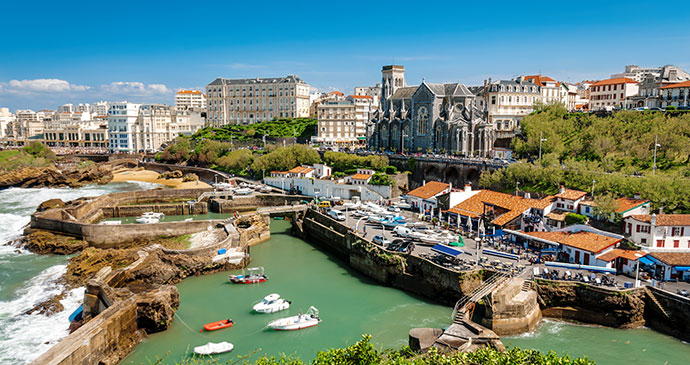
Biarritz
British visitors may find Biarritz reminiscent of an English south coast resort in its 19th-century prime. Just add a pier, and you’d need only the smallest helping of imagination to complete the pretty picture. Often mentioned in the same breath as French seaside icons such as Cannes or Saint-Tropez, the town’s very name still conjures up an image of glitz and glamour, even though the Belle Époque came to an end over a hundred years ago.
With its elegant period villas, stylish hotels and well-trimmed green spaces, this is a town that has looked after itself. The celebrities that once graced the town might have moved on, but if they ever chose to come back, then Biarritz would be ready to welcome them with style. In the meantime, surfers bring their own vibe to town, mastering the waves and the equally difficult art of riding scooters while clutching their giant boards.
The town undulates, stretching itself out along its many beaches, its sandy and rocky shore. As far as the eye can see – and that’s usually quite far – the vista beyond is now of the uninterrupted sands that fringe the coastline of the neighbouring department of Les Landes.
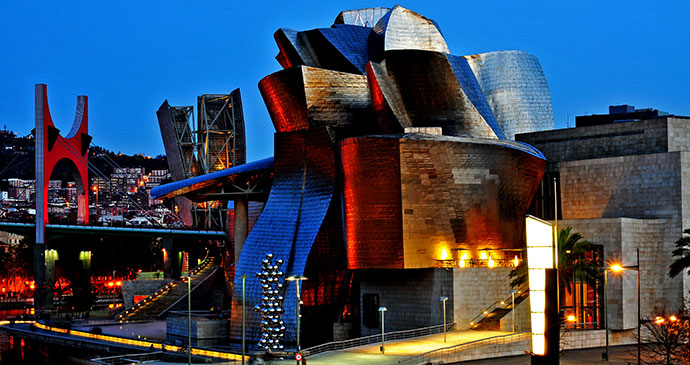
Bilbao
The undisputed urban giant in the Basque territories, Bilbao is a smart, innovative, lively city, which has emerged from a difficult past with a strong identity.
The inhabitants have a reputation in the rest of the Basque Country for being proud, maybe a bit too proud, but they can laugh at themselves as well. And they have plenty to be proud of. By night, it’s a city full of life, but it’s not in a hurry to wake up, especially on Sunday mornings – a great time for a stroll if you’re hankering after some tranquillity.
There’s something hugely masculine about Bilbao, but ignoring the city simply because it lacks the obviously seductive qualities of San Sebastián would be a massive mistake; this giant is a solid testament to urban reinvention. Some places look better from a distance than at close quarters, but Bilbao is not one of them; once you are in the heart of the city, pleasant surprises await.
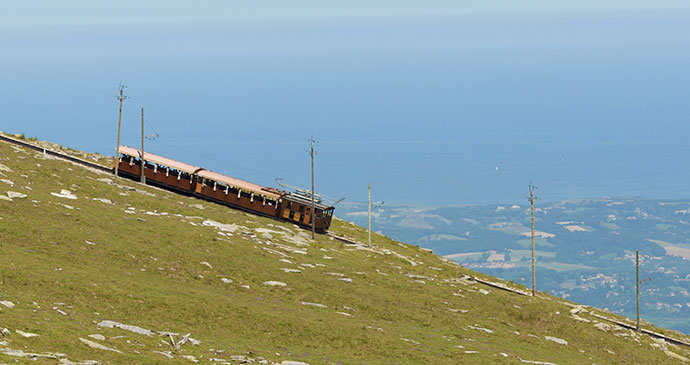
La Rhune
Although not exactly high in Pyrenean terms, at a trifling 905m, La Rhune somehow dominates the skyline for many miles around, visible from all directions. And it has something going for it that none of the bigger summits can offer: you can get to the top without any effort at all, using the Train de La Rhune. Since 1924 this emblematic train has hurtled up the slopes of La Rhune at a leisurely 9km per hour, using a rack and pinion system to get traction on slopes that average 18%. The view from the top, if you are blessed by the weather, is a stunning 360° panorama of the seven Basque-speaking provinces. You can choose to travel by train one-way and hike the other, or simply return on the train, perhaps after a bit of shopping or dining at the many ventas (shops) that await you at the top. For walkers, there is the opportunity to meet up with the pottok horses, sheep and perhaps see some of the vultures overhead.
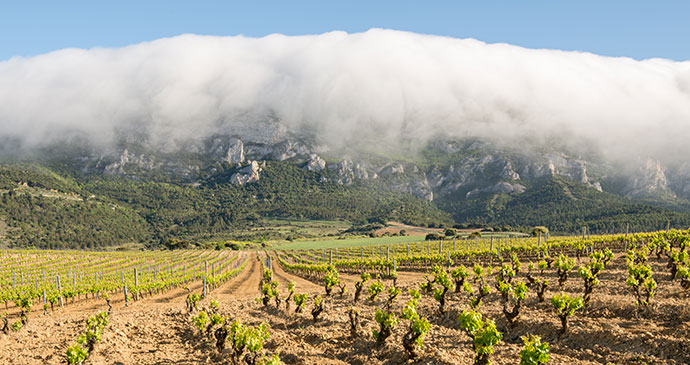
Laguardia and Rioja Alavesa
The Sierra Cantabria rudely divides Álava from west to east, and south of the mountain range you’re in a region that’s a world apart from the rest of the Basque Country. Everywhere is covered in vines and you don’t have to guess how people make their living in the Rioja Alavesa. Here, there are more hectares of vineyard than there are inhabitants and you can taste, drink, buy – even bathe in – their liquid products. The Romans can take the credit for bringing viniculture to the area, but it’s only since the 1970s that the production of wine here has become truly commercially focused.
Now, wine tourism is very firmly established too and, as well as visitors from other parts of Spain, Americans, Australians, British, Germans and many others flock here to indulge, tasting the wines in bodegas that range from medieval caves to architect-designed eccentricities. While the vine dominates, cereals and olives are also grown, though the latter’s importance is less than it was a hundred years ago.
As well as the agricultural landscape, the small towns that punctuate it are attractive, too: Laguardia (Biazteri) is the jewel, its strategic, lofty location at one time making it ‘the Guardian of Navarre’, as it watched out for armies approaching from Castile. Now, its pedestrianised old town oozes charm and points of interest, with over 250 caves lurking beneath its narrow streets. The southern border of Álava is defined by the River Ebro, beyond which lies the province of La Rioja.
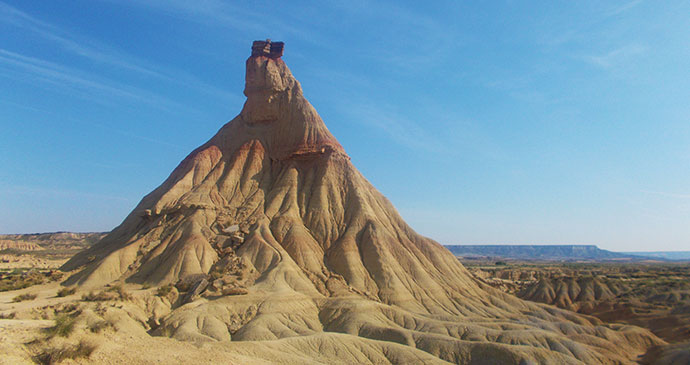
Las Bardenas Reales
Navarre’s film-star semi-desert, the Bardenas Reales, was first designated a natural park in 1999 and as a biosphere reserve a year later. The wonders of the landscape are self-evident once you are inside the park, but other peculiarities are not so obvious. First of all, the area is owned by 20 nearby communities, as well as by the nearby Monasterio de la Oliva, and the distant valleys of Roncal and Salazar in the Pyrenees. Rights of perpetual pasturage were granted by the king in centuries long gone, giving the territory its Real (Royal) title. Every year from 18 September, shepherds bring their flocks of sheep down the cañadas reales (drovers’ routes) from those valleys to avoid the Pyrenean winter, and stay until April or May. Some small waterholes have been created to supply the flocks, while the shepherds live in the nearby towns.
Secondly, this heavily protected area has a military base and firing range in its very middle. Every day in clear weather, Spanish air force jets arrive from Zaragoza, screaming down from above, dropping dummy bombs and occasionally live ammunition on to targets said by locals to be neatly arranged to represent Middle Eastern airbases. Needless to say, many locals want the base removed from this beautiful, rugged location, but the Government pays the communities richly for its presence and there seems little chance of the situation altering anytime soon. For first-time visitors, the planes are an additional attraction in themselves, perhaps the closest many people will (hopefully) ever come to being in a war zone.
Curiously, Bardenas Reales’s incredible scenery attracts a mere 50,000 visitors annually to marvel at how nature has sculpted the landscape over a period of millions of years. And yet many locals will exclaim that this is still a little-known natural wonder, under the radar even of many Spaniards. Indeed, the French account for over half the visitors.
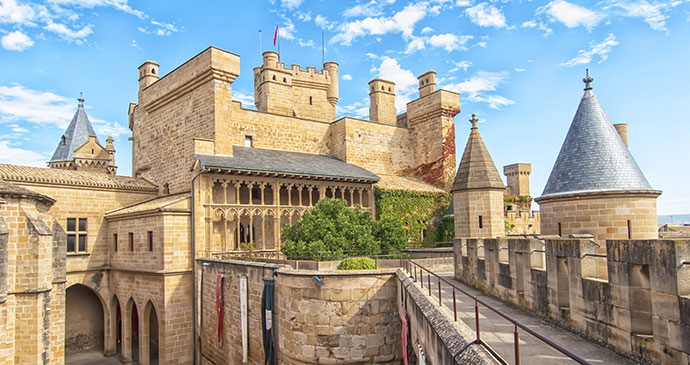
Olite
Once of enormous importance for strategic reasons, Olite was formerly one of the chosen seats of the Kings of Navarre, owing its medieval prosperity to the privileges granted to it by King García Ramírez in the year 1147. The foundation of the town probably stretches back to AD621, but a walled Roman settlement was undoubtedly sited here long before then. Now the town’s significance derives from tourism and wine production, the latter encouraged by the Mediterranean climate and evidenced by the many bodegas in and around town, many of which can be visited. And as for alcohol-free tourism, Olite has the Palacio Real, an outstanding French Gothic-style monument dating from the 14th and 15th centuries and restored to great glory over a 40-year period starting in the 1930s. Ask an eight-year old child to draw a palace and they might come up with something like this, all towers and pointy turrets. But despite its notable visitor attractions, Olite remains largely unspoilt, with its narrow medieval streets, noble houses and ample squares almost totally free of the souvenir shops that can be found in myriad places of lesser interest.
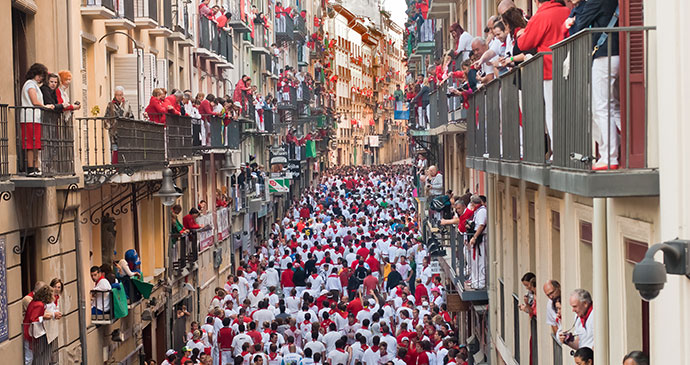
Pamplona
Pamplona is the only major conurbation in Navarre and thus unrivalled as the capital of the autonomous community. The city marches to at least two distinct beats. Its fast-forward setting shows itself during the nine days in July when it is overwhelmed by the frenzied festival of San Fermín, an internationally acclaimed party throwing together delirious locals with hardcore visitors to take part in – or more wisely, to watch – the bull-running that has become the city’s hallmark. How important is the festival? The digital clock at the end of Calle Estafeta, which counts down to the start of the festival (and is reset immediately after it finishes) gives you the answer. Marching to an altogether different beat, pilgrims descend slowly into town from Roncesvalles, largely between April and September, to enjoy the urban facilities quite frequently denied to them en route to Santiago.
For the rest of the year, Pamplona returns to its normal self, a pleasant place to live and visit. Recently, it has claimed the title of having the ‘most green space per inhabitant’ of any city in Spain, though Vitoria-Gasteiz might raise an eyebrow at that accolade. Certainly, from the Parque Taconera, populated by deer and peacocks, to the Japanese-themed Parque Yamaguchi, the sculpture park in the ciudadela and the peacefulness of the Parque Media Luna, there are plenty of open parkland to enjoy.
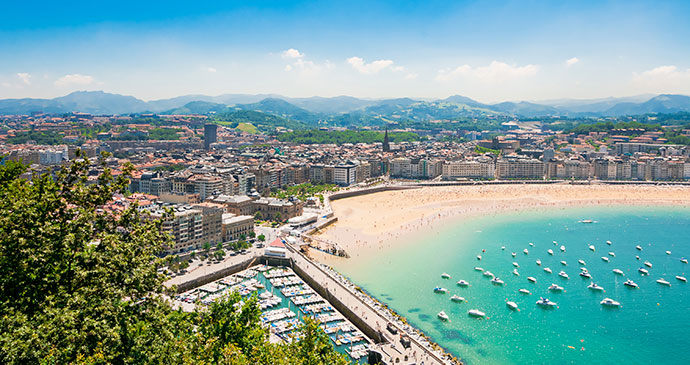
San Sebastián
If you wanted a shortcut to designing the ideal city, then cloning San Sebastián (known locally as Donostia) would be an excellent way to start. Cradled in a perfectly shaped bay, it boasts a quartet of beaches waiting to welcome everyone from lazy sunbather to adrenaline-pumping surfer. Gorgeous stretches of sand right on the doorstep might be enough for some cities to rest on their laurels, but San Sebastián doesn’t stop there, comfortably accepting its accolades as a global gastronomic giant and its frequent appearances in most ‘world’s best cities’ lists, and rejoicing in the vibrancy of its festivals, which stretch from the chic internationalism of its annual film festival and its well-established jazz festival to the unbridled raucousness of January’s tamborrada. And all the while it basks in the elegance of its Belle Époque buildings. Here, above all, is a city seemingly entirely happy in its own skin, and while it is certainly accepting of the many, many visitors who flock here from Spain and further afield, it draws its true strength from simply being a very fine host to its own citizens throughout the year.
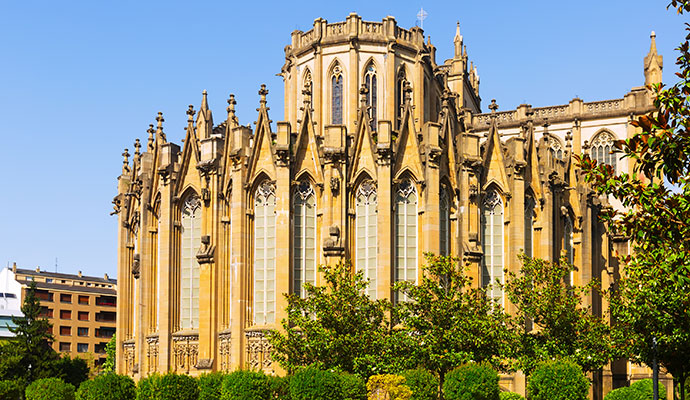
Vitoria-Gasteiz
Understated, under-visited and hardly a household name: here’s a well-organised city with a great quality of life, getting on quietly with its day-to-day business, enjoying its weekends and counting down the days to its vibrant festivals. And when it comes to those, Vitoria’s inhabitants can surely compete with all comers in any ‘letting your hair down’ tournament.
Vitoria was officially named ‘European Green Capital, 2012’, and its environmental credentials are much in evidence as you wander around the city, from its green belt and six parks to its cycle paths, pedestrianised old town streets and nearby wetlands – a haven for birdlife. Indeed, Vitoria was the very first Spanish city to sport a bicycle path, and each citizen has over 40m2of green space. Mountains are present on the horizon on three sides, and that green belt will extend to over 1,000km2 when the plan, devised in the 1990s and constantly evolving, is complete. No-one can say that the city doesn’t make the most of this accolade. Not only do the inhabitants talk the talk, but they walk the walk too. And run, speed-skate and cycle their way around town (so much so that they have banned the use of bicycles in the old town, not that many people take any notice, of course). Using Vitoria’s green belt, you could cycle all the way around the city’s perimeter, a distance of 30km.
Related books
For more information, see our guide to the Basque Country:
Related articles
Beautiful Basque ticks all the boxes for those seeking sunny wide-open spaces with less footfall.
Once a proud European kingdom and a former haunt of Hemingway, Navarre still has plenty to offer curious visitors.
